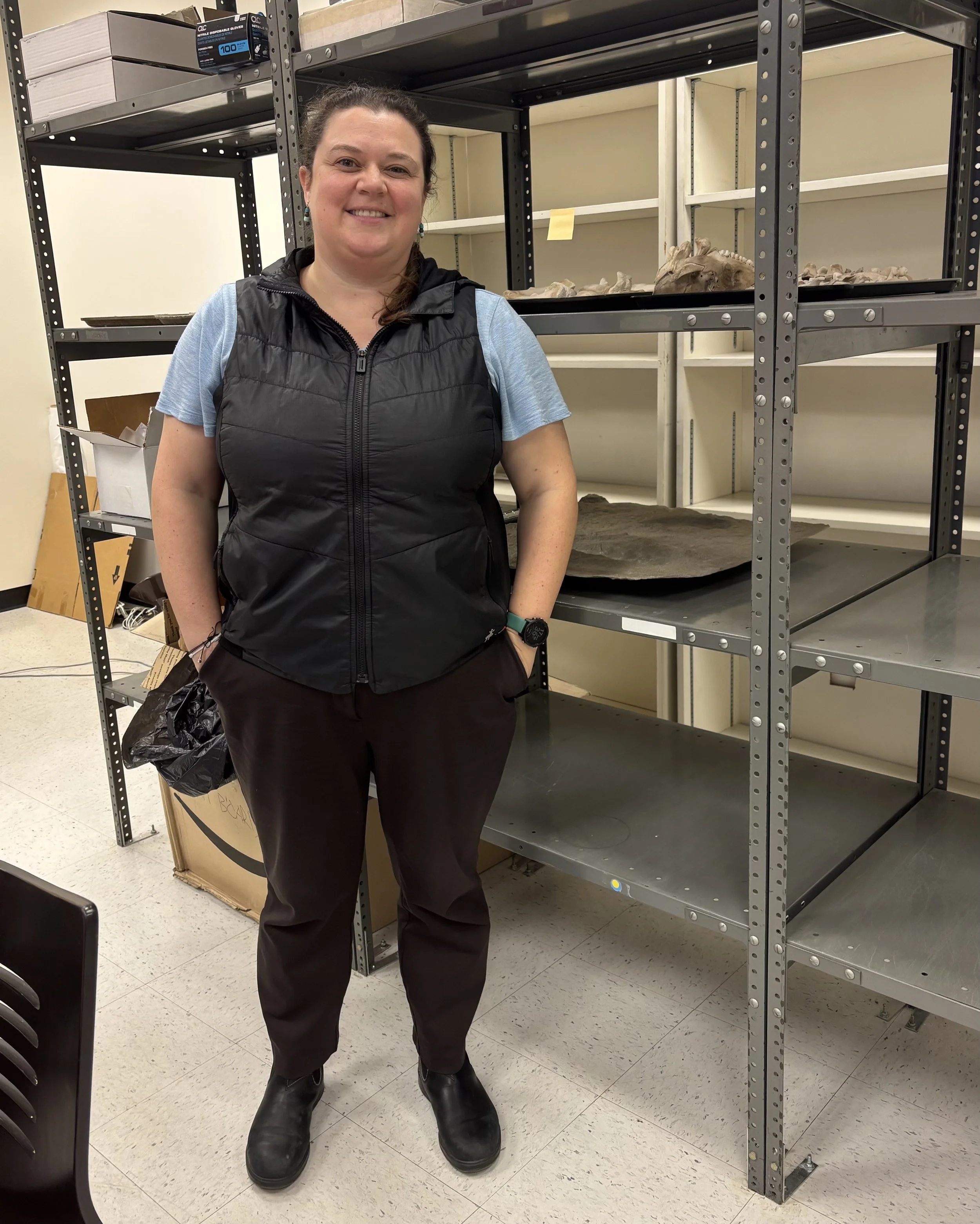The subtle arts of blowing up pigs and sorting mass graves
Story and photos by Katie Everett
Petra Banks stands by pig bones that are part of research in her lab on October 29, 2025.
Fairbanks is home to the state’s only forensic anthropologist, Petra Banks. Banks works as a researcher and professor at the University of Alaska Fairbanks, and is currently in the beginning stages of research that will help to bring more forensic anthropology to Alaska. Recently, The Sun Star had the opportunity to interview Banks about her research and how she became involved in the unique field.
Banks earned her undergraduate degree in theater, but had always been interested in science. She had the opportunity to take an anatomy and physiology class, and they led to her interest in the human skeletal system. She went back to University of Alaska Anchorage to obtain her bachelor's degree in forensic anthropology.
“Forensic anthropology is the study of humans in a forensic context,” said Banks.
It’s all about skeletons, what to do when they are found, how to identify them, and looking at different trauma that might be present.
Banks completed her master’s degree in Mississippi and her Ph.D. at Texas State University, where she worked at the decomposition facility.
Texas State University has the largest decomposition facility in the country, and as a graduate student Banks had the opportunity to volunteer and do research there. Banks was responsible for processing skeletal collection donors.
In her time at UAF Banks has been working in the field of taphonomy.
“Taphonomy is the process that a body or any skeleton, any living thing goes through after death,” Banks explained.
Banks is specifically looking for how long it might take for a body to fully decompose, and how bone condition changes. The taphonomic research in Banks’s lab is in the very early stages, meaning there are more developments to come.
Before becoming involved in taphonomic research, Banks performed blast experiments in her PhD program at Texas State University.
Petra Banks shows the human skull on a skeleton on October 29, 2025.
In these experiments, Banks was looking for distinct trauma patterns. The experiment involved packing C4, a powerful explosive, into a ball and placing it about one meter away from the subject. The C4 was detonated and afterwards, Banks would look at how the trauma from the explosion was distributed throughout the skeleton of the subject, which was usually a deceased pig.
Regarding how Banks came by this C4, she explained, “officially it is through the San Antonio Police Department.”
Banks approached the Federal Bureau of Investigation with a research proposal, but they were concerned about being directly involved. So the FBI supplied the San Antonio Police Department with the C4 that Banks used in her experiments.. The San Antonio Police Department assisted Banks in her experiment by handling the C4.
From taphonomic research to blast experiments, Banks has earned lots of experience.Banks said that her favorite aspect of the job is the variety of it. She can spend time consulting with medical examiners in Anchorage one day and the next be back up in Fairbanks teaching a class, or go to the Museum of the North to consult.
Banks also had the opportunity to travel to the Republic of Georgia last fall to help excavate mass graves from the Soviet Union-era and hopefully identify people to get them back to their families. Banks stated that this experience was one of the most important things she has done at work, because she got to be part of a project that helped provide closure to several families. Banks said that one day, while working on excavating, family members came to the work site. The team allowed these family members time to be with the exposed remains and have resolution that their family members might finally be identified.
Banks noted that this was an incredibly moving moment, seeing the impact of events even decades later.
Banks’s trip to Georgia illustrated that forensic anthropology has real-life applications. Her work in identifying victims helps to give a voice back to those victims. Banks has used isotopic analysis of bones to determine where someone may have lived based on what water they drank, depending on the presence of strontium in their bones. Another method for identification is looking at an x-ray before a person died and an x-ray after, and matching specific features to each other.
The work that Banks does involves more sensitive topics, as it revolves around investigating causes of death and identification of deceased persons. Banks explained that everyone in the field of forensic anthropology has a different reaction anytime they enter a forensic situation. She’s never had a bad reaction, but that does not mean it won’t happen down the line. The variability of scenarios that forensic anthropologists are in make it hard to predict exactly how one will react. However, Banks emphasized the importance of a good network of friends. Having other people to talk to, who can relate, is crucial for processing difficult cases.
Banks aims to continue to further her career by diving into taphonomy. She dreams of opening a decomposition facility here in Alaska, and as the state’s only forensic anthropologist, she is helping pave the way for many important developments in her field up here in Fairbanks.
Banks will have a talk on “Identifying Victims of The Great Terror (1936-1938) in Batumi, Georgia” from 3 to 5 p.m. on Friday, November 7 in the Charles Bunell 302 anthropology classroom. There is also the option to attend via Zoom. For more information, follow the link here.



